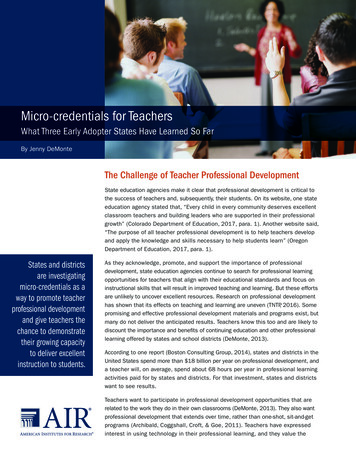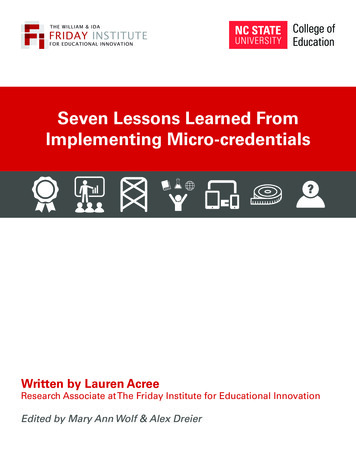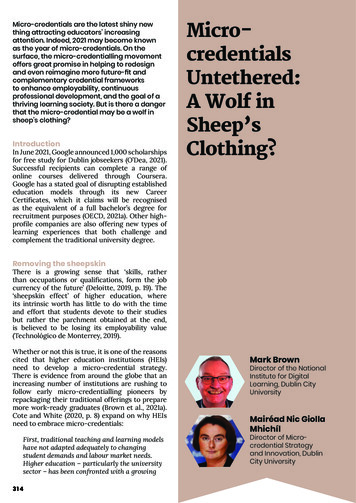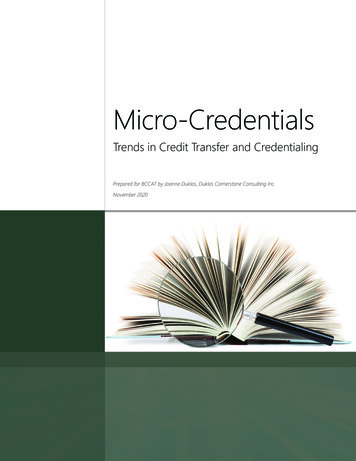
Transcription
Micro-credentials for TeachersWhat Three Early Adopter States Have Learned So FarBy Jenny DeMonteThe Challenge of Teacher Professional DevelopmentState education agencies make it clear that professional development is critical tothe success of teachers and, subsequently, their students. On its website, one stateeducation agency stated that, “Every child in every community deserves excellentclassroom teachers and building leaders who are supported in their professionalgrowth” (Colorado Department of Education, 2017, para. 1). Another website said,“The purpose of all teacher professional development is to help teachers developand apply the knowledge and skills necessary to help students learn” (OregonDepartment of Education, 2017, para. 1).States and districtsare investigatingmicro-credentials as away to promote teacherprofessional developmentand give teachers thechance to demonstratetheir growing capacityto deliver excellentinstruction to students.As they acknowledge, promote, and support the importance of professionaldevelopment, state education agencies continue to search for professional learningopportunities for teachers that align with their educational standards and focus oninstructional skills that will result in improved teaching and learning. But these effortsare unlikely to uncover excellent resources. Research on professional developmenthas shown that its effects on teaching and learning are uneven (TNTP, 2016). Somepromising and effective professional development materials and programs exist, butmany do not deliver the anticipated results. Teachers know this too and are likely todiscount the importance and benefits of continuing education and other professionallearning offered by states and school districts (DeMonte, 2013).According to one report (Boston Consulting Group, 2014), states and districts in theUnited States spend more than 18 billion per year on professional development, anda teacher will, on average, spend about 68 hours per year in professional learningactivities paid for by states and districts. For that investment, states and districtswant to see results.Teachers want to participate in professional development opportunities that arerelated to the work they do in their own classrooms (DeMonte, 2013). They also wantprofessional development that extends over time, rather than one-shot, sit-and-getprograms (Archibald, Coggshall, Croft, & Goe, 2011). Teachers have expressedinterest in using technology in their professional learning, and they value the
flexibility it gives them to create their own schedule for engaging in professional learning(Will, 2017a). In addition, teachers in rural or remote areas need access to high-qualityprofessional learning opportunities through technology when other options do not exist(Will, 2017b).Why Micro-credentials?The challenge of providing high-quality, relevant, flexible, and broadly accessibleprofessional learning experiences for teachers has led some states to investigate andexperiment with the use of micro-credentials for teacher professional development.Micro-credentials offer a strategy for teachers to expand and validate their learning and toreceive recognition as they achieve milestones in their professional learning trajectories.One reason micro-credentials are appealing is that they break down complexinstructional skills into fundamental parts. Educators can develop and demonstratecompetence in each bite-sized element of instruction, and then weave together theseskills to demonstrate mastery in complex skills. Teachers can choose which skill, orwhich parts of a skill, would most benefit their professional practice, and then they candemonstrate their competency by providing evidence of what they know and can do.For states, micro-credentials have noteworthy benefits. For one, states can more easilyoffer micro-credentials that are aligned with teaching standards and other state initiatives(for example, to support efforts to help all teachers develop the skills needed to teachEnglish language learners). For another, micro-credential training is often delivered online,meaning it can be more accessible to rural educators and those who need to engagein professional learning in the evening, on weekends, or during school breaks. Lastly,states using micro-credentials demonstrate their support for educators’ abilities tounderstand their own professional learning needs.Many aspectsrelated to the design,implementation,and impacts ofmicro-credentialscould benefit fromfocused studies.2Currently, the research on micro-credentials for educators is thin. Most of the availableresearch is based on teacher feedback about their own use of micro-credentials. Forexample, a report by Teaching Matters (2016) on the use of leadership micro-credentialsnoted that teachers like using micro-credentials, they thought the skills they had to learnto earn a micro-credential were important, and they believed that their learning wouldlead to greater student learning. Another report by Digital Promise (2016a) of teacherswho pursued micro-credentials revealed that teachers liked the approach and felt thattheir practice had improved through earning them. The Friday Institute at North CarolinaState University (Acree, 2016) designed 15 micro-credentials, collected survey andinterview data from teachers earning the micro-credentials, and reported their findingsin a report. Among the findings: Teachers earning micro-credentials use what theyhave learned in their teaching, and the design and online platform have an effect onthe experience of users. The report included examples of the artifacts provided byteachers as evidence of their competency related to the instructional skill laid out inthe micro-credential.Many aspects related to the design, implementation, and impacts of micro-credentialscould benefit from focused studies. For example, it would be useful to know how microcredentials influence teachers’ instructional practice. Does demonstrating teaching
competency by earning a micro-credential translate into observable differences inteachers’ classroom practices? What structures or processes are more advantageousor effective when implementing micro-credentials? Which instructional or other skillsand competencies best lend themselves to the use of micro-credentials? How shouldmastery of the targeted skills be assessed and documented? Should micro-credentialsbe a complement or supplement to other professional development approaches? Whatother issues should states, districts, and micro-credential issuers consider as theydevelop and use micro-credentials?Early implementing states can offer some lessons learned about using micro-credentials.The Origins of Micro-credentials: Workforce TrainingMicro-credentials have their roots in the “digital badge” movement that first gained tractionas a way to support adult learning for the workforce. One of the earliest players was a groupcalled Open Badges, created by Mozilla Foundation in 2013 with funding from the MacArthurFoundation.1 Open Badges specified technical standards for digital badges and provided aplace where individuals could collect badges that met these technical standards. The previousyear, Mozilla and Peer 2 Peer University in collaboration with MacArthur (2013) released aworking paper that described their vision of digital badging as a vehicle for lifelong learning foradults. The same year, the Clinton Global Initiative announced an effort to expand access toOpen Badges to help workers certify their skills and improve their economic futures (MacArthurFoundation, 2013). Since then, hundreds of issuers have created and posted badges on manydifferent sites that can be earned in a variety of disciplines and fields. In January 2017, theIMS Learning Consortium took over a notable portion of Open Badges’ responsibilities.Around the same time, a report published by American Institutes for Research in 2013(Finkelstein, Knight, & Manning, 2013)—funded by the U.S. Department of Education’sOffice of Vocational and Adult Education—noted that digital badges could help validatefunctional skills valued in workplace settings. Among the examples highlighted in the reportwere Badges for Veterans (to help them validate military job skills for civilian settings) andthe Manufacturing Institute’s National Manufacturing Badge System. A number of industriesuse digital badging as a way for workers to demonstrate and be recognized for specificcompetencies. The Interstate Renewable Energy Council, for example, offers badges totrainers and instructors that recognize their ability to lead learning.2 TechWriter Certificationawards badges to those who demonstrate competence in technical writing.3Meanwhile, education organizations noted teachers’ growing interest in technology—such asTwitter chats, online courses, and EdCamps—to help them connect to their colleagues and toprovide access to better professional learning (Digital Promise, 2016b). The growing interest inand experimentation with digital badges among industry and adult learning advocates likelycontributed to the exploration of micro-credentials for teacher professional development.123For more information about Open Badges, see https://openbadges.org/about/.For more information on the Dynamic Digital Credential from the Interstate Renewable Energy Council,see rtification/dynamic-digital-credential/.For more information about the TechWriter Certification, visit http://techwriter-certification.com/index.html.3
Commonly, each microcredential addresses afine-grained, discrete setof educational practices.What Are Micro-credentials for Teachers?Micro-credentials are an approach to professional learning that provides teachers withthe opportunity to learn and demonstrate competency in new skills, while also gettingfeedback from an outside evaluator and earning recognition for mastery by earning themicro-credential. Commonly, each micro-credential addresses a fine-grained, discreteset of educational practices.There are hundreds of micro-credentials available, which have been created by dozensof different “issuers.” Some are available to anyone who wishes to try to earn them,such as those on the public webpage at the Digital Promise website.4 Others have beendesigned specifically for a state, district, or program and are not publicly available. Theexact cost charged by the issuer depends on the arrangements between states andissuers, but typically the cost of scoring is included.In addition, BloomBoard—the company that provides the technical platform for manymicro-credentials—has partnered with five universities that will award credits towarda graduate degree to someone completing a designated micro-credential.5 The microcredentials available for graduate credit are marked by a yellow banner on the website.6The cost of the credit and its value toward graduation differ depending on the university,from 40 to 75.7Almost always each micro-credential is part of a “stack” that is organized around aparticular area of teaching. For example, a stack of micro-credentials titled “Checkingfor Understanding” includes three separate micro-credentials: Using Ask, Ask, Ask;Using Gestures; and Using Whiteboards. Another stack titled “Data Literacy” includesDesigning and Evaluating Multiple Choice Questions, Disaggregating Data, and SettingGoals for Students.8 To earn a micro-credential, a teacher must demonstrate competencyin the specific skill—a skill already mastered or a skill new to the teacher who needs tostudy and practice before collecting and providing evidence of competency.A teacher considering pursuing a micro-credential will typically go to the hosting website,click on the name of the micro-credential, and find: the objective of the competency to be demonstrated through the micro-credential; the research supporting the efficacy of the teaching competency; resources to support learning the teaching competency, such a weblinks tovideos or written texts; the evidence that must be submitted to earn the micro-credential; and the rubric and scoring for how that evidence will be assessed.456784See 2f23c8-274d-449d-ac3f-6ad29e399737.The five universities are Brandman University, Fresno Pacific University, University of the Pacific, PortlandState University, and University of San Diego.See the BloomBoard micro-credential website: 2f23c8-274d-449d-ac3f-6ad29e399737.See https://bloomboard.com/graduate-credit.See 2f23c8-274d-449d-ac3f-6ad29e399737.
Often, the evidence required to earn a micro-credential includes a video of instruction,student work, answers to open-ended questions, reflections, or a combination ofthese. When the teacher has collected evidence that she believes demonstrates herachievement of the teaching competency, she uploads it to the link included in theonline platform. This evidence is sent to a scorer who reviews the evidence, scoresit against a rubric, and then determines whether the teacher has earned the microcredential.When the scoring is complete, the teacher is notified whether she has earned themicro-credential. In most cases, the teacher will receive specific feedback fromthe scorer about the quality of the evidence. If the teacher did not earn the microcredential, then the scorer indicates what she could do to improve the evidence.The teacher can resubmit evidence as needed.How States Are Using Micro-credentialsStates and districts use micro-credentials as a resource to supplement traditionalprofessional development and as a way for teachers to demonstrate competency ininstructional skills. In some states, the micro-credentials can count as professionaldevelopment “credit” toward requirements for retaining a teaching license. For example,North Carolina and Wisconsin allow districts to decide whether to use micro-credentialsfor this purpose (Sawchuk, 2016).Teachers usually can choose from a selection of state education agency preapprovedmicro-credentials to personalize their own professional learning. For example, the KettleMoraine school district in Wisconsin was researching competency-based educationwhen it learned about micro-credentialing for teachers. The district incorporated microcredentials into its professional development program, which allows teachers to proposecourses of study for themselves and pursue micro-credentials aligned with the coursetopic (Sawchuk, 2016). Teachers who completed micro-credentials could earn smallbase-salary increases.In some states, themicro-credentials cancount as professionaldevelopment “credit”toward requirementsfor retaining ateaching license.What Early Adopter States Have LearnedThree early adopter states—Arkansas, Delaware, and Tennessee—offered to sharewhat they learned so far. Officials in these states are quick to point out that they arestill learning how best to use micro-credentials. What they have already learned mighthelp other states looking into micro-credentialing as a means to address the currentneeds and challenges with traditional teacher professional development. Other statesthat have started to give teachers the option of using micro-credentials for their continuingeducation units include Illinois, Maryland, Massachusetts, Montana, New York, NorthCarolina, Texas, and Wyoming.99BloomBoard’s question-and-answer page helps teachers determine how to receive credit (https://help.5
The lessons learned offered by these three states fall into the following five categories: Decide on your purpose Start small Provide choice (but not too much) Keep an eye on the score Communicate, communicate, communicateDecide on Your PurposeAs states begin to use micro-credentials, leaders must make decisions on the intendeduse and goals. This first step is critical because dozens of stacks of micro-credentialsare available. Knowing the intended use will make it easier to select appropriatemicro-credentials.Having an articulated purpose for micro-credentials will help guide the program design.In addition, having a well-stated purpose can help states collect and interpret informationgleaned from their initial use of micro-credentials. For example, a well-defined purposeallows states to consider questions such as: Did teachers use micro-credentials asintended? Did teachers believe the micro-credentials included in the program helpedthem learn intended skills?Tennessee educationofficials ultimately settledon two purposes for theirmicro-credential effort:to offer personalizedprofessional learning toeducators and to developan innovative approachto educator licensure.To shape their micro-credential pilot, state education officials in Delaware determinedthat micro-credentials would be used to give teachers additional choices for professionaldevelopment. Michael Watson, chief academic officer and associate secretary for theDelaware Department of Education, said that he and his colleagues gave considerablethought to redesigning professional learning and wanted to give teachers the opportunityto be in charge of their professional learning. “This is one avenue to personalizeprofessional learning for an educator,” Watson said. “We believe that deep, engaging,ongoing professional learning is what good professional development looks like. Teacherswant great professional development that’s not a one-shot event. Micro-credentials canbe part of that.”10In Arkansas, state education leaders started with a different perspective. “First, wehad to decide what we really wanted someone getting a micro-credential to know,”said Sandra Hurst, director of educator effectiveness in Arkansas. Early on, the statedepartment of education began using micro-credentials as part of the inductionprogram for new educators. “We’re also thinking about using them to offerprofessional development on the science of reading,” Hurst said.Tennessee education officials ultimately settled on two purposes for their microcredential effort: to offer personalized professional learning to educators and todevelop an innovative approach to educator licensure, said Machel Mills, al).All quotations were obtained from personal conversations with the author in preparation of this report.
professional learning systems, Tennessee Department of Education.11 “When we weremaking plans to start using micro-credentials, the first step was to make sure it wasgoing to be a learning experience for our educators,” Mills said. Her advice for statesstarting to think about using micro-credentials: “Have a strong rationale for how andwhy you plan to use micro-credentials because there are lots of paths you take whenyou get into it.”Start SmallAlthough determining and articulating a specific purpose helps states launch a focuseda micro-credentialing pilot program, starting with a small number of educators can helpthem uncover complexities or unintended outcomes while the program is easily managedgiven its small size.State educators in Delaware emphasized the importance of starting with a small pilotprogram and learning from that experience. “On the surface, this doesn’t appear complex,but the work is actually very complex,” said Watson. For example, states might learn thatsome of the micro-credentials selected for the program are not attractive to teachers,whereas others are extremely popular. States might want to reconsider what constitutesappropriate evidence for earning a micro-credential after reviewing the evidence submittedby teachers in a pilot program. Watson said his advice to other states starting a microcredentialing program would be to “start very small, and take your time. Micro-credentialshave so much potential, and I’d hate to see them disappear because we didn’t go at itslow enough.” Delaware’s pilot program started with just 19 teachers. Tennessee’s 2016pilot program began with a similar number of teachers.State educators inDelaware emphasizedthe importance ofstarting with a smallpilot program andlearning from thatexperience.Jennifer Kabaker, director of educator micro-credentials at Digital Promise, said herorganization has worked with about 15 districts to launch small pilot programs. “Youstart small so you can learn about what works, and then refine your approach as youscale up,” she said. For example, by starting small states can get firsthand knowledgeof the kind of evidence teachers submit. States might review the evidence and decideto choose a different micro-credential to offer before they scale up the program forhundreds of teachers—one that might be more closely aligned to state initiative.One key to designing a good, small pilot program is to target the micro-credentials fora specific purpose and group of teachers. “Some [states] decide to start with theirnovice teachers, and so they focus the micro-credentials they choose on fundamentalteaching skills, like classroom management,” Kabaker said. “Others might start withtheir coaches, who are already high-flyers, and use micro-credentials to give themsupport and learning that will help them give feedback to mentees.”11Tennessee included a description of the pilot program using micro-credentials in its state plan submittedto the U.S. Department of Education under the Every Student Succeeds Act (see ts/ESSA Draft Plan Full.pdf).7
Provide Choice (But Not Too Much)A frequently cited strength of micro-credentials is that they allow teachers to personalizetheir professional learning. Officials in states that have piloted micro-credential programsagree. “One of the goals of our micro-credentialing program was to offer teachers ‘voiceand choice’ in their professional development, something that teachers always say theywant,” said Tennessee’s Mills. Tennessee, like the other states quoted in this brief,selected the micro-credentials to be made available to teachers and then allowedteachers to choose which they wanted to earn.Arkansas chose to offermicro-credentials thatalign with the Frameworkfor Teaching, the rubricused in its teacherevaluation system.Arkansas chose to offer micro-credentials that align with the Framework for Teaching,the rubric used in its teacher evaluation system.12 State officials selected a handfulof micro-credentials related to Domain 2: Classroom Environment and Domain 3:Instruction, and these options were offered to teachers in the pilot program. Teacherscould choose which micro-credential to work on, but the choice “set” for microcredentials was limited to those that state officials believed were directly relatedto their state’s instructional standards.Watson, in Delaware, said this work is akin to curating a large collection to find themost useful pieces. The work of selecting is important because it sets the stage forthe professional learning for educators. “The menu that is offered becomes theopportunity for teacher learning,” he said.Keep an Eye on the ScoreWhen teachers submit materials required to earn a micro-credential, those artifactsand evidence go to a scorer. Often, scorers work for the organization issuing or hostingmicro-credentials, but in some cases, scorers work for the state education agency.13The scorer, who has been trained to evaluate submissions using a rubric often specificto each micro-credential, reviews the submitted evidence (e.g., video of teaching, studentwork, and/or teacher responses to questions) required to earn the micro-credential. Ifthese receive sufficient scores on the rubric, then the teacher is notified that she hasearned the micro-credential.Understanding how micro-credentials are scored is something states should pay closeattention to, said Delaware’s Watson. “Looking at scoring is an important step forstates getting involved in micro-credentials,” he said.In Arkansas, state education officials focused on the process for scoring and qualityassurance. Hurst said that she and her team made sure that everyone in leadershipunderstood the importance of the scoring process. “We made sure everyone hereunderstood the importance of having people score with validity so we had qualityassurance,” she said.12138For more information on the Framework for Teaching, visit http://www.danielsongroup.org/framework.For example, Digital Promise, Teaching Matters, and BloomBoard all employ and train scorers.
Mary Strain, director of national partnerships at Teaching Matters, said that evenbefore they begin scoring a district’s micro-credentials, they work closely with thedistrict to create a program that is meaningful to the district. “Micro-credentials candefine what a school system values, so the content that is offered is important.”Scoring then becomes a critical part of ensuring that the micro-credentials documentthese skills that are meaningful to the district. “We spend a tremendous amount oftime norming scoring, so we have a good idea of what competency in a particular skilllooks like across the system,” Strain said. “Because of this, district officials can beassured that what is being scored is valid, reliable, and meaningful.”Communicate, Communicate, CommunicateState officials in Arkansas, Delaware, and Tennessee agreed that communication wasessential to their early work in micro-credentialing, whether that meant bringing theright people to the table to do the work or beefing up technology tools so teacherscan connect with each other.In Arkansas, Hurst said that she quickly realized that she needed to get her state’seducation leadership up to speed on micro-credentials for the program to be asuccess. “We got started and got great feedback, so we sat down with leadershipto show them all the steps involved. Not just the creation of micro-credentials, butwhere do you house them, how does the submission process work, and so on,” shesaid. “We started with our small team, but then pulled in the school improvementteam and strategic planning team.” In addition to communicating with the leadershipteam, Hurst had to spearhead efforts to get the legislature to change the language inthe legislation related to professional development to move away from accumulatinghours of professional development toward allowing micro-credentialing to count forrequired professional learning. Hurst’s efforts were successful.State officials agreedthat communicationwas essential to theirearly work in microcredentialing, whetherthat meant bringing theright people to the tableto do the work or beefingup technology tools soteachers can connectwith each other.“Delaware’s role is to convene the correct people to understand, work on, andimplement the program,” said Watson. In this case, that meant bringing educatorsfrom the field to be part of the process early on. “We are doing this from the groundup, and we are doing this with teachers,” he said.Tennessee made sure to include new and experienced teachers by asking veteransto reach out to novices. “When we sent invitations to participate in the pilot toexperienced teachers, we asked them to invite a novice teacher to join them in theprocess. We wanted to embed the spirit of collaboration into the micro-credentialingwork from the beginning,” said Mills. One communication issue that surfaced duringthe early micro-credentialing work was the lack of a strong online community amongeducators. “We did not have a robust online community, and we want to improve thatso that our teachers across the state can share and learn from each other,” Mills said.9
What Is Next for Micro-credentialingEven though micro-credentials are gaining in popularity for teacher professionaldevelopment across districts and states, there are still a number of importantareas for future work.A powerful piece ofresearch would be tostudy teachers’ practicesbefore and after earninga micro-credential or astack of micro-credentialsto detect differencesthat may have beeninfluenced by earningthe micro-credential.First, there is a need for systematic research on micro-credentials as states continueto experiment with them. The initial responses from teachers noted above are heartening;teachers often like earning a micro-credential and see the value in improving theirprofessional practice. But a stronger research agenda could start with work to cataloguethe purposes states have for using them as well as the micro-credentials they chooseto match those purposes. Another line of research might be to study the design andcontent of different micro-credentials as a first step toward understanding whetherand how earning them influences what teachers know and can do. Do design differencesaccount for variation in teacher competencies after earning a micro-credential? Thescoring of micro-credentials presents its own set of questions. For example, is ahigher or lower score on the micro-credential related to whether teachers retain thecompetency they may have learned? A powerful piece of research would be to studyteachers’ practices before and after earning a micro-credential or a stack of microcredentials to detect differences that may have been influenced by earning the microcredential. Documenting changes in teaching practice and any impact on studentlearning could be beneficial in determining micro-credentials’ return on investment fordistricts and states. Such research could indicate that earning a micro-credential isa signal of what teachers know and can do to improve student learning.Second, although micro-credentials can influence teaching practice, they are likelybest implemented as part of larger professional learning strategy for teachers. Forexample, if teachers receive coaching related to a specific skill, then engaging in amicro-credential would help a teacher and coach know whether the coaching washelpful. Or, in the example from the Kettle Moraine
offer micro-credentials that are aligned with teaching standards and other state initiatives . micro-credential training is often delivered online, meaning it can be more accessible to rural educators and those who need to engage in professional learning in the evening, on weekends, or during school breaks. . Fresno Pacific University .










